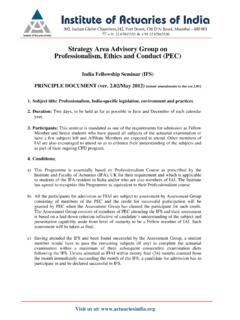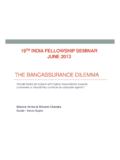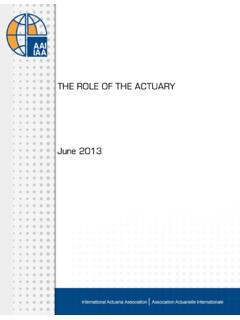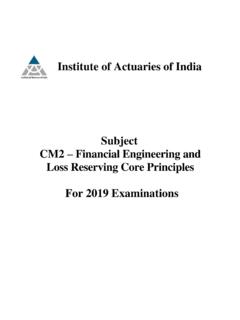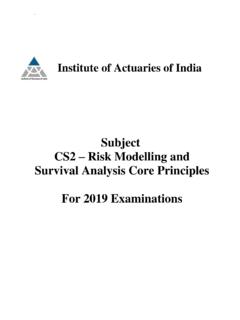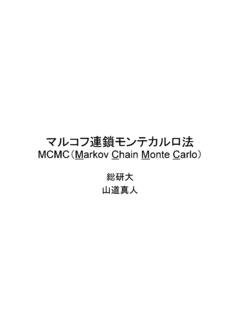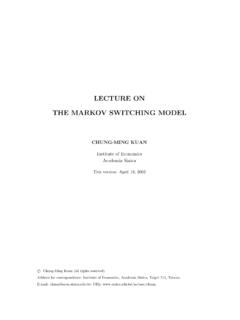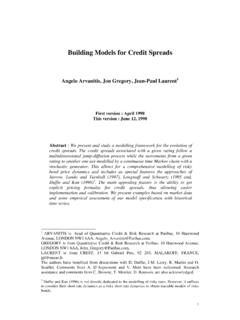Transcription of Subject CT4 – Models
1 Institute of Actuaries of India Subject CT4 Models For 2018 Examinations Subject CT4. Models Core Technical Syllabus 1 June 2017. Subject CT4 Models Core Technical Aim The aim of the Models Subject is to provide a grounding in stochastic processes and survival Models and their application. Links to other subjects Subject CT1 Financial Mathematics: provides an introduction to stochastic interest rates. Subject CT3 Probability and Mathematical Statistics: introduces the concepts of statistical distributions and modelling. Subject CT5 Contingencies: develops the application of Markov chains. Subject CT8 Financial Economics: develops the concepts introduced here further. Subject CA1 Actuarial Risk Management and the Specialist Technical subjects use the Models and principles introduced in this Subject .
2 Objectives On the successful completion of this Subject the candidate will be able to: (i) Describe the principles of actuarial modelling. 1. Describe why and how Models are used. 2. Explain the benefits and limitations of modelling. 3. Explain the difference between a stochastic and a deterministic model, and identify the advantages/disadvantages of each. 4. Describe, in general terms, how to decide whether a model is suitable for any particular application. 5. Explain the difference between the short-run and long-run properties of a model, and how this may be relevant in deciding whether a model is suitable for any particular application. 6. Describe, in general terms, how to analyse the potential output from a model, and explain why this is relevant to the choice of model.
3 7. Describe the process of sensitivity testing of assumptions and explain why this forms an important part of the modelling process. 8. Explain the factors that must be considered when communicating the results following the application of a model. Page 2. Subject CT4 Models Core Technical (ii) Describe the general principles of stochastic processes, and their classification into different types. 1. Define in general terms a stochastic process and in particular a counting process. 2. Classify a stochastic process according to whether it: operates in continuous or discrete time has a continuous or a discrete state space is a mixed type and give examples of each type of process. 3. Describe possible applications of mixed processes. 4. Explain what is meant by the Markov property in the context of a stochastic process and in terms of filtrations.
4 (iii) Define and apply a Markov chain. 1. State the essential features of a Markov chain model. 2. State the Chapman-Kolmogorov equations that represent a Markov chain. 3. Calculate the stationary distribution for a Markov chain in simple cases. 4. Describe a system of frequency based experience rating in terms of a Markov chain and describe other simple applications. 5. Describe a time-inhomogeneous Markov chain model and describe simple applications. 6. Demonstrate how Markov chains can be used as a tool for modelling and how they can be simulated. (iv) Define and apply a Markov process. 1. State the essential features of a Markov process model. 2. Define a Poisson process, derive the distribution of the number of events in a given time interval, derive the distribution of inter-event times, and apply these results.
5 3. Derive the Kolmogorov equations for a Markov process with time independent and time/age dependent transition intensities. 4. Solve the Kolmogorov equations in simple cases. 5. Describe simple survival Models , sickness Models and marriage Models in terms of Markov processes and describe other simple applications. Page 3. Subject CT4 Models Core Technical 6. State the Kolmogorov equations for a model where the transition intensities depend not only on age/time, but also on the duration of stay in one or more states. 7. Describe sickness and marriage Models in terms of duration dependent Markov processes and describe other simple applications. 8. Demonstrate how Markov jump processes can be used as a tool for modelling and how they can be simulated.
6 (v) Explain the concept of survival Models . 1. Describe the model of lifetime or failure time from age x as a random variable. 2. State the consistency condition between the random variable representing lifetimes from different ages. 3. Define the distribution and density functions of the random future lifetime, the survival function, the force of mortality or hazard rate, and derive relationships between them. 4. Define the actuarial symbols t px and t qx and derive integral formulae for them. 5. State the Gompertz and Makeham laws of mortality. 6. Define the curtate future lifetime from age x and state its probability function. 7. Define the expected value and variance of the complete and curtate future lifetimes and . derive expressions for them.
7 Define the symbols ex and ex and derive an approximate relation between them. 8. Describe the two-state model of a single decrement and compare its assumptions with those of the random lifetime model. (vi) Describe estimation procedures for lifetime distributions. 1. Describe the various ways in which lifetime data might be censored. 2. Describe the estimation of the empirical survival function in the absence of censoring, and what problems are introduced by censoring. 3. Describe the Kaplan-Meier (or product limit) estimator of the survival function in the presence of censoring, compute it from typical data and estimate its variance. 4. Describe the Nelson-Aalen estimator of the cumulative hazard rate in the presence of censoring, compute it from typical data and estimate its variance.
8 5. Describe Models for proportional hazards, and how these Models can be used to estimate the impact of covariates on the hazard. Page 4. Subject CT4 Models Core Technical 6. Describe the Cox model for proportional hazards, derive the partial likelihood estimate in the absence of ties, and state the asymptotic distribution of the partial likelihood estimator. (vii) Derive maximum likelihood estimators for the transition intensities in Models of transfers between states with piecewise constant transition intensities. 1. Describe an observational plan in respect of a finite number of individuals observed during a finite period of time, and define the resulting statistics, including the waiting times. 2. Derive the likelihood function for constant transition intensities in a Markov model of transfers between states given the statistics in 1.
9 3. Derive maximum likelihood estimators for the transition intensities in 2. and state their asymptotic joint distribution. 4. State the Poisson approximation to the estimator in 3. in the case of a single decrement. (viii) Describe the Binomial model of mortality, derive a maximum likelihood estimator for the probability of death and compare the Binomial model with the multiple state Models . 1. Describe the Binomial model of the mortality of a group of identical individuals Subject to no other decrements between two given ages, in the naive case where all lives are observed for exactly one year. 2. Describe the advantages of the multiple state Markov model compared with the Binomial and Poisson Models , in terms of (a) how well each model represents the process being modelled; (b) how easy it is to find, characterise and use the model parameters, given the data; and (c) how easily each model is extended to problems other than the study of human mortality.
10 (ix) Describe how to estimate transition intensities depending on age, exactly or using the census approximation. 1. Explain the importance of dividing the data into homogeneous classes, including subdivision by age and sex. 2. Describe the principle of correspondence and explain its fundamental importance in the estimation procedure. 3. Specify the data needed for the exact calculation of a central exposed to risk (waiting time) depending on age and sex. 4. Calculate a central exposed to risk given the data in 3. Page 5. Subject CT4 Models Core Technical 5. Explain how to obtain estimates of transition probabilities, including in the single decrement model the actuarial estimate based on the simple adjustment to the central exposed to risk.

